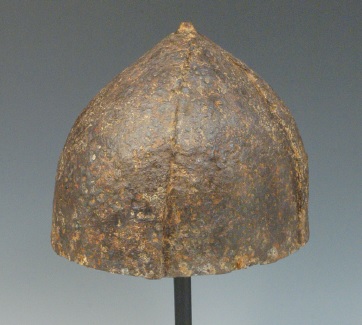http://www.timelineauctions.com/pdf/Catalogue-Antiquities.pdf
I don't know whether this has been posted before or not but the text seems to contain enough information to make a reconstruction.
Norman - Four-Plate Rivetted Spangenhelm Helmet.
210mm high, 175mm diameter; 1.71kg. Circa 11th century AD. An extremely rare iron helmet fabricated from four triangular iron plates skillfully made to accommodate the curvature of the human head and with a slight point at the apex; contoured so that the front and back plates overlap the side-plates by 1-2cm with iron rivets passing through this overlap to secure them in position; the rivets worked flat into the surface of the helmet, and almost invisible from the outside but detectable on the inner surface; the inverted lower rim furnished with an additional series of rivets, probably to accommodate a lining; two empty rivet-holes at the base of the side-plates, where the cheekplates were originally attached; the plate-junction at the apex left slightly open, allowing a plume or horsehair streamer to be inserted or a covering plate to be attached.
